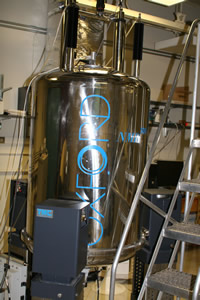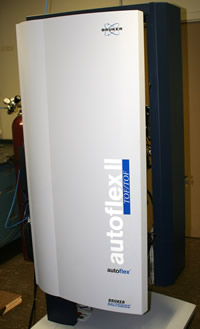Research Facilities
Chemistry Library
The Chemistry Library is located on the 2nd Floor of the Graduate Chemistry Building, Room 299. The new 2nd floor reading room has been completely renovated with new furniture providing seating for 90 people. The reading room houses the Chemistry Library’s reference collection and current print journals. The remainder of the collection, including the back issues of print journals, books, theses and spectral data, is located in the basement of the Chemistry Building. Library staff will retrieve items from the basement facility upon request.
In keeping with modern library design, the reading room accommodates both individual and group study. For those interested in quiet study, there are carrels set along the windows overlooking the “Zebra Walk”. For users wanting to access the thousands of online library resources including SciFinder , the Web of Science, Reaxys, and electronic journals, the computer area includes eight networked PCs. The new lounge section, featuring eight modern leather chairs, provides a comfortable space to sit and read. For group study, the Library is furnished with many tables including some with inset whiteboards for drawing formulas and equations to help facilitate group interaction and learning. The library is open from 8:30am - 5pm Monday - Friday.
NMR Facility

The NMR Facility at Stony Brook University is housed in locations at the Department of Chemistry and at the nearby CMM Building. The NMR Facility is currently composed of 6 superconducting NMR instruments operating at 850 MHz, 700 MHz, 500 MHz, 400 MHz, and two instruments operate at 300 MHz proton frequencies. The 850 MHz, 700 MHz, 500 MHz, 400 MHz, and one of the 300 MHz instruments are recent whole system purchases and upgrades from Brüker Biospin Corp. The remaining 300 MHz NMR instrument is a vintage Varian Instruments Gemini 2300 system. All instruments are pulsed Z-gradient and variable temperature capable. The 850 MHz, 700 MHz, and 500 MHz, instruments are full multi nuclear three or four RF channel research grade instruments with full cold probe technology available for enhanced 1H and 13C observation at 850 MHz and 700 MHz, and full 1H/X liquid nitrogen temperature enhanced observation available at 500 MHz. These instruments are dedicated to the support of research programs in structural biology, chemistry, and materials sciences. They are capable of a wide variety of contemporary liquid state experiments at 5 mm sample size. Solid state CP-MAS NMR experiments are supported at 850 MHz with a 2.5 mm 1H/ X probe tunable from 15N – 31P with MAS rates up to 35 kHz and high power 1H decoupling. A 3.2 mm CP-MAS Probe is also available with fixed 13C and 15N observe channels and high power 1H decoupling with MAS rates up to 24 kHz and a third 1H/X MAS probe is available at 4 mm with a tunable X channel covering the range from 15N – 109Ag where MAS rates up to 15 kHz are available with high power 1H decoupling. For more details please visit the NMR facility webpage.
Mass Spectrometry Facilities
 Our synthetic and biological programs are facilitated by state-of-the-art mass spectrometry
instrumentation. We are fortunate to have both instrumentation and expertise available
within the chemistry building in the ICBDD Analytical Laboratory and within our School of Medicine Biological Mass Spectrometry Lab. The departmental, ICBDD mass spectrometry instrumentation includes an Agilent 1260LC/G6224
oaTOF, a Bruker AutoFlex II MALDI-TOF/TOF, an Agilent 1100LC/G1956A MSD and an Advion
CMS. The extensive instruments available in the SOM BMS lab are listed on their webpage.
Our synthetic and biological programs are facilitated by state-of-the-art mass spectrometry
instrumentation. We are fortunate to have both instrumentation and expertise available
within the chemistry building in the ICBDD Analytical Laboratory and within our School of Medicine Biological Mass Spectrometry Lab. The departmental, ICBDD mass spectrometry instrumentation includes an Agilent 1260LC/G6224
oaTOF, a Bruker AutoFlex II MALDI-TOF/TOF, an Agilent 1100LC/G1956A MSD and an Advion
CMS. The extensive instruments available in the SOM BMS lab are listed on their webpage.
Materials Characterization
Critical to the success of our strong program in materials chemistry is the availability of modern, state-of-the-art instrumentation for structure elucidation of both crystalline and amorphous materials. Stony Brook is extremely well equipped to conduct such research, with 2 single crystal diffractometers and 3 wide bore NMR machines in the Department of Chemistry, and powder diffractometers, microscopes (SEM, TEM, and AFM), high pressure cells for synthesis, etc. available on campus. Scattering experiments, designed to probe polymer properties such as crystallization, gelation and micellization are performed in-house, and at synchrotron sources such as the NSLS-II or the Advanced Photon Source, where dedicated instruments are available.
Computational Resources
Recently significant investments have been made to support the excellent and growing computational community at Stony Brook. The first is the installment of New York Blue, a $26 million dollar supercomputer, under a cooperative agreement between Stony Brook and Brookhaven National Labs. The second is the founding of the Laufer Center for Physical and Quantitative Biology, located in 15,000 square feet of newly renovated space. It will be home to 5 PIs, more than 40 students, junior fellows, and postdocs, in addition to administrative staff and a state of the art computational resource. These recent developments enhance an already thriving community that had previously taken advantage of the Seawulf computational cluster, a 240 Teraflops Linux cluster composed of 164 compute nodes, each with two Intel Xeon E5-2683v3 CPUs.
